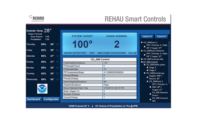If you’ve been in the radiant world for a while, you’re no doubt familiar with the standard snow- and ice-melting systems for commercial applications: sidewalks, driveways, parking lots, parking ramps — the basics.
These types of applications typically are requested by clients looking to meet various environmental, health and safety (EHS) or the Americans with Disabilities Act (ADA) requirements. Some also want these systems to help protect from slip-and-fall-injuries and lawsuits.
Hydronic radiant snow- and ice-melting systems are a smart way to make easy work of clearing surfaces so people can walk and drive unencumbered during inclement weather. The systems feature a warm water/glycol mixture that circulates through PEX pipe embedded in the concrete slab or in the ground.
These systems can be effectively used in any exterior area, including stairs, sidewalks, driveways, parking lots, parking ramps, loading docks, building entrances, wheelchair access ramps, hospital emergency entrances and even helipads on rooftops. Almost any area that accumulates snow or ice can benefit from one of these systems.
But if you think outside the box, you can incorporate a snow- and ice-melting system in areas where few have gone before. Let’s look at three unique applications where innovative engineers took snow- and ice-melting to a new level, providing the safety and convenience of the application in a totally new way.
Stadium roof catch basins
If you watched the Philadelphia Eagles beat the New England Patriots in Super Bowl LII in February, you viewed a structure with one of the most unique applications in the country.
The U.S. Bank Stadium in Minneapolis, Minnesota features a snow- and ice-melting system in the roof catch basins around the upper perimeter of the building. Why snow catch basins? If you remember back in December 2010, the roof collapsed on the old Metrodome stadium (home of the NFL’s Minnesota Vikings) after nearly a foot-and-a-half of snow accumulated, sagging the Teflon and fiberglass fabric dome roof.
Thankfully, no one was hurt. But, it got the engineers thinking when it came time to design the new 1.75-million-square-foot stadium which opened in July 2016. About 60% of the stadium’s new roof is made of Ethylene Tetra Flouro Ethylene (ETFE), a durable, lightweight plastic-like roofing material that’s been used for three decades in construction. The remainder of the roof features a traditional steel deck and membrane style.
Designing the roof with a 1:12 pitch and adding a special glaze that deflects sunlight and aids in melting allows the snow to slide off and into catch basins around the stadium’s upper perimeter. The basins, which range in width from 5 to 40 feet, cover a total area of about 58,000 square feet.
The floors of the basins include an embedded hydronic radiant snow- and ice-melting system that automatically melts snow on contact, enabling the melted snow (i.e., water) to run down a drainage system.
The project used 70,000 feet of 3/4” PEX radiant tubing that was prefabricated into custom-designed mats that arrived on the jobsite in large rolls. The installers simply unrolled the pre-pressurized mats and connected the headers to the supply and return manifolds.
Commuter rail platform
The Northstar commuter rail, which runs along one of the most congested and fastest-growing corridors in Minnesota, from Big Lake (located about 40 miles northwest of the Twin Cities) to downtown Minneapolis, features various stations at each stop.
The main station in Ramsey, Minnesota, consists of two passenger platforms that are 425 feet long and 26 feet wide. To ensure the safety of commuters from slips and falls, the city decided to embed a snow- and ice-melting system into the concrete platforms.
“We installed a total of 48,000 feet of 3/4-inch PEX tubing laid 6 inches on center,” says Greg Koba of Burnsville, Minnesota-based Klamm Mechanical. “The design included six manifold boxes and 20 radiant manifolds placed every 85 feet, which were embedded in the sidewalk butting up to the platforms.”
The design also included eight, 2-inch PEX main lines for each platform that run from two manholes in the landscape area, then enter the slabs and stub into the manifold boxes. The two manholes connect through a 16-inch jacket housed underneath the track that also holds the two 4-inch main lines that supply the platform.
Interestingly, the design originally called for HDPE piping, but Klamm Mechanical realized HDPE would not be able to provide the Btu required for the system. “HDPE pipe is not designed to handle the type of system this project required,” Koba says. “We were able to change specifications with the engineering firm to PEX tubing.”
Koba also noted one of their biggest concerns was ensuring the supply and return piping to the manifolds did not compromise the structural needs of the system. ”By using large-dimension tubing to feed all the manifolds, we were able to route the system efficiently and correctly,” he says.
Year-round playgrounds
With an average annual snowfall of 15 feet, Steamboat Springs, Colorado, is familiar with the white, fluffy stuff. But, that amount of snowfall can really put a damper on outside play for active school children.
The school district was looking for a solution that offered safety for the kids, but also provided low maintenance. They chose to have a hydronic radiant snow- and ice-melting system installed in the playgrounds of Strawberry Park Elementary and Soda Creek Elementary, offering the kids a safe, dry surface to play on during recess.
The system not only gave the children an opportunity for play year round, it also offered the school district added peace of mind because it limited liability concerns associated with slips and falls on the snow and ice.
According to Pascal Ginesta, director of maintenance, operations and transportation for the Steamboat Springs School District, the systems basically are designed the same as a commercial sidewalk or residential driveway system, but with a slight variation.
“The difference is we’ve applied a layer of soft material on the concrete substrate,” he says. “The system has its own natural-gas boiler with hydronic lines that circulate through the concrete to warm it and melt the snow and ice.”
The system is activated from a sensor that detects falling snow and cues the boiler. When the snow stops, the sensor sends a signal to turn the boiler off. This energy-efficient design means the system functions only during a snowfall, which never has a chance to accumulate.
However, according to Ginesta, they learned an important lesson with the first winter after the system was installed. During the winter break, a school official at Strawberry Park Elementary turned the system off, which disabled the automatic snow and ice melting. It snowed quite a bit during that time and, with the system off, the snow accumulated and had to be shoveled away.
“That was a lesson learned,” he says. “Now the system is turned on all winter long, yet only activates during a snowfall.”
Heat sources can be unique
In addition to new and innovative installation applications, there also are smart ways to provide sustainable heat sources to make snow- and ice-melting systems more efficient and effective.
Standard heat sources for these types of hydronic radiant systems can range from traditional boilers (electric, condensing, cast-iron and modulating-condensing) to more modern technologies, such as waste heat, geothermal and excess solar production.
To provide an example of how these systems can work, the city of Holland, Michigan, installed a sustainable system in the streets and walkways of its downtown area and used waste heat as the heat source, essentially providing free energy to the system.
For the design, PEX tubing serves as the cooling mechanism for the turbines in the city’s power plant. River water pumps to water-to-water heat exchangers where heat from the turbines transfers to the loops, raising water temperature to 80° to 90° F for the snow- and ice-melting system. Two pumps circulate the water through the system and the water then returns to a nearby river at an acceptably cool temperature.
Innovative thinking outside the box is the method to making snow- and ice-melting systems work smarter, faster, easier and more sustainably (and we’re not just talking for the environment — they can be more sustainable for the bottom line as well).
If you want to learn more about hydronic radiant snow- and ice-melting systems, visit the Radiant Professionals Alliance at www.radiantprofessionalsalliance.org.





